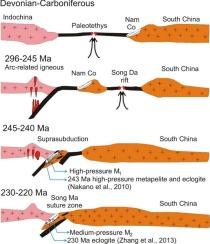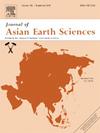Metamorphic evolution and tectonic implications of high-pressure metapelites from the Song Ma suture zone, between the South China and Indochina cratons
IF 2.4
3区 地球科学
Q2 GEOSCIENCES, MULTIDISCIPLINARY
引用次数: 0
Abstract
High-pressure metapelites from the Song Ma suture zone provide crucial insights into the tectonometamorphic evolution of convergent plate boundaries between the South China and Indochina cratons. Two distinct metamorphic stages (M1 and M2) are identified. M1 is characterized by relict inclusions of garnet, quartz, white mica, chlorite, monazite within albite porphyroblasts, with internal fabrics (S1) ranging from straight to sigmoidal and discontinuous to the major foliations (S2) indicating pre-S2 formation. M2 assemblages include porphyroblasts of garnet, albite, quartz and white mica, chlorite, monazite in the matrix, almandine is higher than spessartine from core to rim of garnet. The P–T conditions of M1, constrained by isochemical phase diagrams and geothermobarometric data, are estimated at 15–17 kbar and 440–475 °C, whereas those of M2 are 11–12.5 kbar and 440–490 °C, suggesting blueschist facies metamorphism followed by the epidote–amphibolite facies. Monazite grains associated with M1 and M2 exhibit compositional and textural differences, indicating distinct metamorphic events. U–Th–Pb isotopic data yield ages of 244 ± 10 Ma (M1) and 234 ± 10 Ma (M2) by SHRIMP, and 241 ± 5 Ma (M1) and 221 ± 4 Ma (M2) by LA–MC–ICP–MS. These results collectively record the burial and subduction of metasedimentary protoliths during the initial stages of crustal convergence, followed by subsequent exhumation during the collisional amalgamation of the Indochina and South China cratons and closure of the Song Da Ocean.

华南-印度支那克拉通间松马缝合带高压变质岩的变质演化及其构造意义
来自松马缝合带的高压变质岩为华南和印度支那克拉通会聚板块边界的构造变质演化提供了重要的认识。确定了两个不同的变质期(M1和M2)。M1的特征是在钠长石卟绿母体内残留石榴石、石英、白云母、绿泥石、独居石等包裹体,其内部织构(S1)从直到s形,不连续到主要的叶理(S2),表明在S2之前形成。M2组合包括石榴石、钠长石、石英和白色云母的卟啉母岩,基质中绿泥石、独居石,石榴石从芯到边缘的铝镁石高于铁镁石。根据等化学相图和地温压资料,M1的P-T条件估计为15-17 kbar和440-475℃,而M2的P-T条件为11-12.5 kbar和440-490℃,表明蓝片岩相变质后为绿长岩-角闪岩相。与M1和M2相关的独居石颗粒表现出成分和质地的差异,表明不同的变质事件。SHRIMP法测定的U-Th-Pb同位素产谱年龄分别为244±10 Ma (M1)和234±10 Ma (M2), LA-MC-ICP-MS法测定的产谱年龄分别为241±5 Ma (M1)和221±4 Ma (M2)。这些结果共同记录了在地壳收敛的初始阶段变质沉积原岩的埋藏和俯冲,随后在印度支那和华南克拉通碰撞合并和宋大洋关闭期间进行了挖掘。
本文章由计算机程序翻译,如有差异,请以英文原文为准。
求助全文
约1分钟内获得全文
求助全文
来源期刊

Journal of Asian Earth Sciences
地学-地球科学综合
CiteScore
5.90
自引率
10.00%
发文量
324
审稿时长
71 days
期刊介绍:
Journal of Asian Earth Sciences has an open access mirror journal Journal of Asian Earth Sciences: X, sharing the same aims and scope, editorial team, submission system and rigorous peer review.
The Journal of Asian Earth Sciences is an international interdisciplinary journal devoted to all aspects of research related to the solid Earth Sciences of Asia. The Journal publishes high quality, peer-reviewed scientific papers on the regional geology, tectonics, geochemistry and geophysics of Asia. It will be devoted primarily to research papers but short communications relating to new developments of broad interest, reviews and book reviews will also be included. Papers must have international appeal and should present work of more than local significance.
The scope includes deep processes of the Asian continent and its adjacent oceans; seismology and earthquakes; orogeny, magmatism, metamorphism and volcanism; growth, deformation and destruction of the Asian crust; crust-mantle interaction; evolution of life (early life, biostratigraphy, biogeography and mass-extinction); fluids, fluxes and reservoirs of mineral and energy resources; surface processes (weathering, erosion, transport and deposition of sediments) and resulting geomorphology; and the response of the Earth to global climate change as viewed within the Asian continent and surrounding oceans.
 求助内容:
求助内容: 应助结果提醒方式:
应助结果提醒方式:


